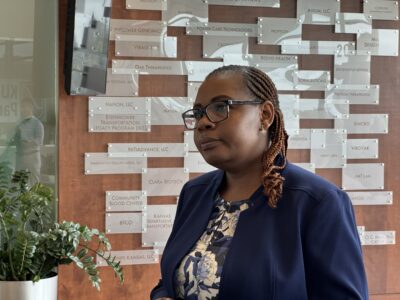Iranian students at KU decry brutal government crackdown; ‘they are killing people in the streets’

photo by: Alastair Grant/AP
Demonstrators hold placards outside the Iranian Embassy in London on Sunday, Sept. 25, 2022. They were protesting against the death of Iranian Mahsa Amini, a 22-year-old woman who died in Iran while in police custody; she was arrested by Iran's morality police for allegedly violating its dress code.
While most University of Kansas students are gearing up for midterms and celebrating the KU football team, one group of students — those from Iran — are losing sleep and agonizing over the fate of loved ones back home.
“Everyone is distracted from their education and classes and projects. … It’s really hard for us to go to sleep at night because there are always new people being killed and arrested,” said a board member of the KU Iranian Community Association, who asked to remain anonymous out of a “big fear of retaliation” that he said all members of the association were now grappling with.
The board member agreed to go by the name Hadis for this story.
“Everyone is being cautious,” he said, noting that it’s not uncommon for students abroad to be monitored and to be reported to Iranian authorities for any “transgressions” against the government, which is in its second straight week of a brutal crackdown on protesters who have been demonstrating against the death of 22-year-old Mahsa Amini.
“Everyone is concerned and worried about their family members and friends. … I think that the news says that 60 people have now died” in the protests, Hadis said.
Amini, a woman from the Kurdistan Province of Iran, died on Sept. 16 in police custody after being arrested for the “moral crime” of not having her hair properly hidden. The official line is that she died of a heart attack, but it is widely believed, including by the KU group, that she was beaten to death by police.
Protests have been raging in cities across Iran, with dozens reportedly killed and more than 1,200 arrested, according to international news reports. The government has shut down internet access to prevent protesters from sharing information with one another and with the outside world.
Still, Iranians in Lawrence are able to glean information from Western news outlets and from various sources within Iran, and they’re watching in horror. Many of them staged their own protest last week on the KU campus and intend to keep raising awareness about what they regard as an increasingly barbaric dictatorship.
“We have lost contact with our families,” said Hadis, who hasn’t been home in several years and doesn’t expect to get there anytime soon.
“It’s kind of impossible for us to go home,” he said, noting the difficulty of routine travel between the two countries, especially with there not being a U.S. embassy in Iran and with the existence of complex visa requirements. Additionally, there are obvious safety fears and the matter of Iran losing its appeal as a place to live and work.
“The smartest people,” Hadis said, “are leaving the country. Scientists, university professors, doctors. Whoever can do this, they are. They are just fleeing.”
“You know how children dream to be a pilot, police officer, teacher, a doctor?” Hadis asked. “In our childhood, our dream is to study hard, to be successful and to leave the country. Isn’t that ridiculous?”
Hadis said the KU Iranian Community Association had been active since May but had stepped up its activities in the past month.
One reason for that is “Iranian students needed some kind of sense of community, some organization that they felt they belonged to … a support system,” said Hadis, who estimated 60 to 70 students and 20 or so faculty members were involved in the association in some capacity. He also noted that the association is meant to support Iranians in the area, even if they don’t attend KU.
Another reason the association was formed was to “promote the rich Iranian culture” — that of Farsi poetry, historic sites like Persepolis, acclaimed Persian art and cuisine — and “not the culture that the current government is promoting.”
“They want everyone to forget all these beautiful things we had,” Hadis said of the government, who he said was only interested in perpetuating minority and misogynistic rule of religious hardliners.
While it was the death of a young woman that triggered the current unrest, Haddis said it’s essentially the death of the country that has people demanding justice in the streets. Today’s protests differ from previous ones that have occurred since the Islamic Revolution in the 1970s, Hadis said, in that people, especially younger Iranians, have given up on the idea of reform.
“Reform is impossible,” he said. “It’s impossible for smart people to get into the system to reform it,” and “the new generation does not believe in the government’s values.”
Hadis said he saw a boldness in the new generation and in the young women who are burning their head coverings in the streets.
“Most of the people that the names are coming out that have been killed in the last 10 days, they are in their 20s,” Hadis said, with a mixture of sadness and respect.
Last week, Iran’s president, Ebrahim Raisi, just days after Amini’s death, appeared at the United Nations in New York to give a speech, which Hadis derided as propaganda and misinformation.
“We want everyone to know what’s really happening in Iran… He’s not our representative … And he talked about human rights while they are killing people in the streets.”







